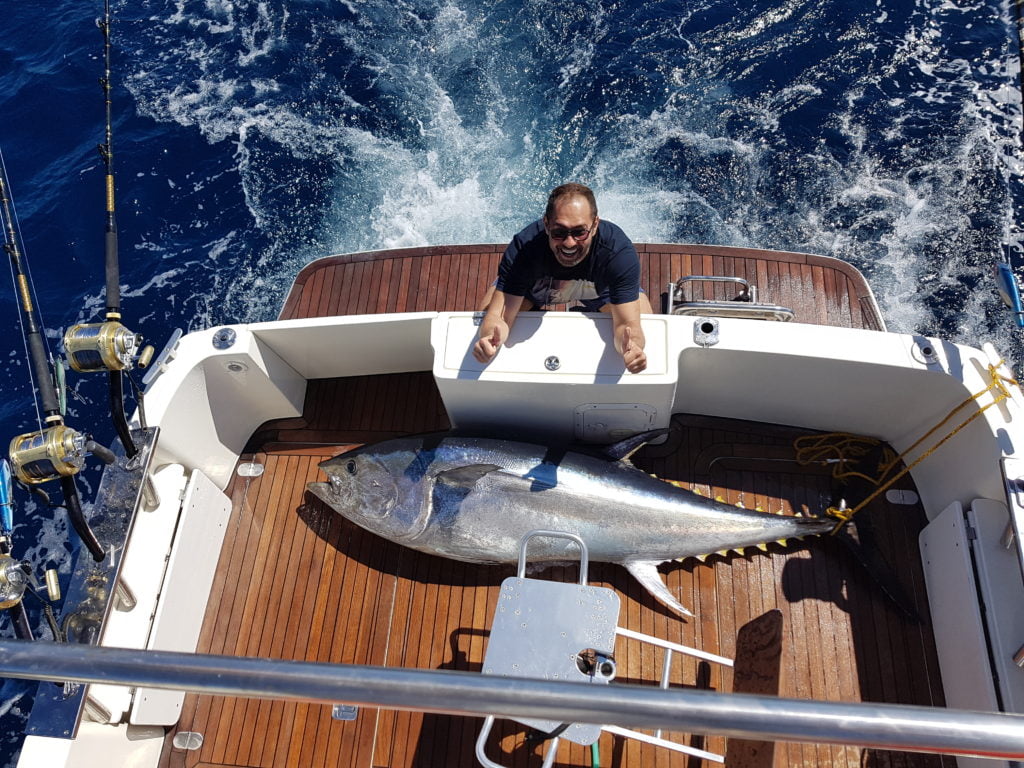Yellowfin tuna vs Bluefin tuna: Quick Guide
The yellowfin tuna and the bluefin tuna, together with the bigeye tuna are the top 3 tunas. They are the biggest and the strongest tuna. Albacore, skipjack, blackfin tuna, longfin tuna, little tunny and bonito also belong to the tuna family, but they’re the smaller cousins.
In this blog post we’ll explain the differences between the yellowfin tuna and the bluefin tuna. They might look similar at first sight, but they have some clear differences. We’ll compare their sizes, their habitats, the best fishing techniques and also their taste. So let’s dive into this quick guide – you’ll distinguish the yellowfin tuna and the bluefin tuna in no time.

Bluefin tuna, caught trolling
The key differences
Size
The bluefin tuna grow much bigger than the yellowfin tuna. Bluefins can grow up to 1000 pounds (500kg). The biggest Bluefin Tuna ever caught was 1496 pounds (780kg). No wonder Ernest Hemingway called the bluefin tuna the “The king of all fish”.
Yellowfins grow very fast, up to 400 pounds (180kg) in about a 7-year lifespan, but don’t grow as big as the bluefin tuna. Yellowfin tuna rarely reach over 500 pounds (225kg).

Jamie releasing a massive Bluefin tuna caught casting in the Strait of Gibraltar
Fin length
Bluefin tuna often get confused with yellowfin tuna because bluefins have bright yellow finlets. To distinguish these fish, you better compare the fin length of the pectoral fins.
The pectoral fins on yellowfin tuna are longer and reach past the second dorsal fin. Bluefins have shorter pectoral fins.
In adult fish, the yellowfin have a much longer second dorsal fin and anal fin. In some large specimens these fins may reach more than halfway back to the tail base.
Bluefin Tuna does not reach past the beginning of the second dorsal fin. A Yellowfin’s pectoral fin is noticeably longer.
Colour
Yellowfin Tuna have a clear yellow lateral line from their head to their tail above the pectoral fins. Bluefins have a dark blue and greenish lateral line.
The second dorsal fin on a yellowfin tuna is bright yellow, whereas those of his bigger cousin are gray and yellow.

Bluefin tuna: dark fins, and greenish lateral line
Tail colour
Although it’s subtle, both fish species have a slight tail colour difference. Bluefin tuna have dark blue tails, while yellowfin tuna tend to have yellow in the tail.

Yellowfin tuna have a yellow lateral line and longer yellow dorsal and anal fins.
Habitats and distribution
Generally speaking, yellowfin tuna prefer warmer waters than bluefin tuna. But to make things more complicated, they often share common habitats; like for example the Canary Islands or Madeira. But you won’t catch a bluefin tuna in Cape Verde; landing a yellowfin in Nova Scotia is rare. Let’s get into detail.

Distribution and habitats of yellowfin and bluefin tuna
Yellowfin Tuna
Yellowfin tuna can be found worldwide in tropical and subtropical oceans. They are pelagic fish and prefer offshore waters, although they occasionally come closer inshore when the temperatures are higher.
Great Yellowfin tuna fishing destinations are Baja California, Southern California (Mexico), Panama, Costa Rica, Hawaii, Caribbean, Cape Verde, Canary Islands (La Gomera, Tenerife, Gran Canaria, Fuerteventura and Lanzarote), Ascension Island and Saint Helena in the Atlantic Ocean, South Africa, Maldives, Madagascar, Mauritius and Sri Lanka in the Indian Ocean.
Bluefin Tuna
Strictly speaking, experts distinguish 3 species of bluefin tuna: atlantic, pacific, and southern bluefin tuna. The three species of bluefin have divided the world’s oceans among themselves, and they roam all planetary seas except the polar. But they prefer the colder to temperate waters. Bluefin tuna migrate from northeast America towards the Mediterranean Sea and the gulf of Mexico for spawning. In the Canary Islands bluefin tuna show up during winter and spring, when the water heats up, the yellowfins take their place.
Pacific bluefins are found widely in the northern Pacific Ocean, from Japan to the Philippine Sea (where they spawn) and from the western coast of North America to all the way down to Mexico.
The southern bluefin tuna is found in open southern Hemisphere waters. They can be found between Java and Australia, New Zealand and South Africa.
Among the best bluefin tuna fishing destinations are Nova Scotia, Madeira, Canary Islands, the Strait of Gibraltar, Ebro Delta and Balearic Islands in Spain, Sicily, Sardinia, Italy and Australia.
So, these are the differences between the yellowfin tuna and the bluefin tuna. Have you ever caught a tuna? Was it a yellowfin or a bluefin? Tell me about the experience (any back pain?? LOL). Let me know and leave your comments below 🙂

